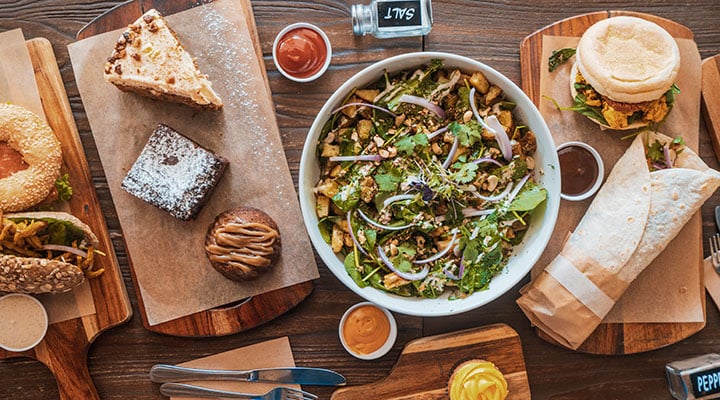The difference between gluten intolerance and coeliac disease
Concerned you may have coeliac disease or gluten sensitivity? Here’s how to tell the difference between the two conditions.
Feeling bloated, nauseous or experiencing frequent bouts of stomach pain? Symptoms like these can be a sign of coeliac disease or gluten intolerance (also known as gluten sensitivity). If left untreated, they can have a significant impact on your long-term health.
So what’s the difference between coeliac disease and gluten intolerance? There’s a lot of crossover between the two conditions, but there are distinct differences in diagnosis and treatment – and whether you need to give up gluten for good.
What is gluten?
Gluten is a family of proteins found in wheat, rye, barley and oats. It often acts as a binding and extending agent, helping foods like bread and pasta maintain their shape. Gluten is added to foods to improve texture and flavour, and to retain moisture.
What is coeliac disease?
Coeliac disease is an autoimmune disease that causes damage to your intestinal wall as a result of eating gluten. Over time, the immune reaction to eating gluten creates inflammation that damages the lining of the small intestine, which can prevent the absorption of some nutrients and lead to nutrient deficiencies and medical complications.
It’s a serious medical condition, and if it’s not controlled or diagnosed – and if gluten isn’t removed from your diet – you risk developing other serious health issues including infertility, depression and osteoporosis, with an increased risk of developing bowel lymphoma (a type of cancer).
For people with coeliac disease – which Coeliac Australia estimates is 1 in 70 Australians – a lifelong gluten-free diet is the only treatment.
“In people with coeliac disease, eating gluten results in damage to the villi – finger-like structures in the small intestine important for digesting and absorbing nutrients – and inflammation of the tissues,” explains dietitian Anna Debenham.
This villi damage reduces the surface area of the bowel, which affects nutrient absorption and causes gastrointestinal symptoms like bloating, nausea, vomiting, constipation and diarrhoea. You can also feel fatigued and irritable.
“A gluten-free diet prevents further damage to the small intestine and allows it to heal so nutrients from food can be properly absorbed,” says Anna.

What is gluten intolerance?
If you don’t have coeliac disease but report similar symptoms, you may have gluten intolerance, or ‘non-coeliac gluten sensitivity’.
After you eat gluten, you might have symptoms like abdominal pain, diarrhoea, tiredness and headaches. The symptoms improve when you avoid eating gluten but return after you reintroduce it. A lot remains unknown about non-coeliac gluten sensitivity.
Research shows what appears to be gluten sensitivity may instead be irritable bowel syndrome (IBS) and an intolerance to FODMAPs – or ‘fermentable oligosaccharides, disaccharides, monosaccharides and polyols’ – a group of carbohydrates found in a variety of foods including wheat, rye and barley.
If you have gluten sensitivity or IBS, you may not need to give up gluten entirely. “People with non-coeliac gluten sensitivity can usually tolerate small amounts of gluten and may need to look at other dietary factors like fermentable carbohydrates,” says Anna.
“The tolerance level varies between individuals. It’s important to manage symptoms by eating below the threshold.”
Getting a diagnosis
You might be tempted to self-diagnose these conditions, but it’s best to seek professional help if you experience recurring gut symptoms. A diagnosis for coeliac disease requires a series of tests while you’re still consuming gluten, explains Anna.
“A blood test will be conducted to measure blood antibody levels that your body produces in response to gluten. After a positive blood test, a small bowel biopsy is carried out to confirm the diagnosis of coeliac disease.”
Non-coeliac gluten sensitivity is not as easy to diagnose. Excluding coeliac disease is the first step. Next you’ll need to see a dietitian to exclude other potential dietary triggers, including high-FODMAP foods like apples, onions, kidney beans and soft cheeses. Then you’ll exclude gluten from your diet and gradually reintroduce it to determine your tolerance levels.
Should you give up gluten?
One study found 25% of Australians avoid eating gluten. But if you haven’t been diagnosed with coeliac disease or non-coeliac gluten sensitivity, there’s no evidence to suggest that going gluten-free will improve your health or energy levels, or help you lose weight.
Gluten-free substitutes can contain more fat and sugar than their gluten counterparts to boost the food’s texture and taste. They can also cost more. So before you change your diet, check with your GP or a dietitian that you’re not missing crucial nutrients.
Words by Caitlin Reid
This article first appeared in the July 2021 edition of Health Agenda magazine.
Related articles
RAISING VEGETARIAN OR VEGAN KIDS
Saying no to animal products is on the rise, but is a vegetarian or vegan diet suitable for children?
Conquering Crohn’s
Despite living with chronic pain, 25-year-old Laura Minns is positive about her life, her future and managing her condition.
Living with a chronic disease
Your mindset can have an impact on how you cope with a chronic illness.
How to fix 7 common diet mistakes
The most common diet mistakes and dietitians’ advice for staying on track.